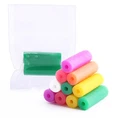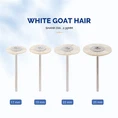Barrier films play a crucial role in automotive parts packaging, offering protection against various environmental factors that could potentially damage the parts during storage and transportation. As a leading supplier of barrier films, I am excited to delve into the details of these essential packaging materials, exploring their types, benefits, and applications in the automotive industry.
Types of Barrier Films for Automotive Parts Packaging
1. Oxygen Barrier Films
Oxygen can cause oxidation and corrosion of automotive parts, especially those made of metal. Oxygen barrier films are designed to prevent the ingress of oxygen, thereby protecting the parts from rust and degradation. These films typically contain a layer of ethylene vinyl alcohol (EVOH) or polyvinylidene chloride (PVDC), which have excellent oxygen barrier properties. For example, EVOH-based oxygen barrier films can reduce the oxygen transmission rate to as low as 0.1 cc/100 in²/24 hr/atm, providing long-term protection for automotive parts.
2. Moisture Barrier Films
Moisture is another major enemy of automotive parts, as it can lead to the growth of mold and mildew, as well as the deterioration of electronic components. Moisture barrier films are used to keep the parts dry by preventing the penetration of water vapor. Polyethylene (PE) and polypropylene (PP) are commonly used polymers for moisture barrier films due to their low water vapor transmission rates. Additionally, metallized films, which have a thin layer of metal (such as aluminum) deposited on the surface, can provide even better moisture barrier performance.
3. Vapor Barrier Films
In addition to oxygen and moisture, automotive parts may also be exposed to various chemical vapors, such as solvents and fuels. Vapor barrier films are designed to block the diffusion of these vapors, protecting the parts from chemical damage. These films often incorporate specialized polymers or additives that have high resistance to specific chemicals. For instance, fluoropolymers are known for their excellent chemical resistance and can be used in vapor barrier films for packaging parts that are in contact with aggressive chemicals.
4. Light Barrier Films
Some automotive parts, such as rubber seals and plastic components, can be damaged by exposure to ultraviolet (UV) light. Light barrier films are used to block UV rays, preventing the parts from fading, cracking, or becoming brittle. These films typically contain UV absorbers or pigments that can absorb or reflect UV light. For example, carbon black is a commonly used pigment in light barrier films due to its ability to absorb a wide range of UV wavelengths.
Benefits of Using Barrier Films in Automotive Parts Packaging
1. Protection of Parts
The primary benefit of using barrier films in automotive parts packaging is to protect the parts from damage. By preventing the ingress of oxygen, moisture, vapors, and light, barrier films can extend the shelf life of the parts and ensure their quality and performance. This is particularly important for high-value parts, such as engine components and electronic systems, which require long-term storage and transportation.
2. Cost Savings
Using barrier films can also result in cost savings for automotive manufacturers. By protecting the parts from damage, manufacturers can reduce the number of defective parts and the associated costs of rework and replacement. Additionally, barrier films can help to reduce the need for expensive packaging materials and protective coatings, further lowering the overall packaging costs.
3. Environmental Sustainability
Many barrier films are recyclable or biodegradable, making them a more environmentally friendly option for automotive parts packaging. By using sustainable packaging materials, automotive manufacturers can reduce their environmental impact and meet the growing demand for eco-friendly products.
4. Improved Brand Image
Providing high-quality packaging for automotive parts can enhance the brand image of manufacturers. By using barrier films to protect the parts, manufacturers can demonstrate their commitment to quality and customer satisfaction. This can lead to increased customer loyalty and repeat business.
Applications of Barrier Films in the Automotive Industry
1. Engine Components
Engine components, such as pistons, cylinders, and crankshafts, are highly susceptible to corrosion and oxidation. Barrier films are used to package these components during storage and transportation, protecting them from the effects of oxygen and moisture. Oxygen barrier films, in particular, are commonly used to prevent the formation of rust on metal surfaces.
2. Electronic Systems
Automotive electronic systems, such as control modules, sensors, and wiring harnesses, are sensitive to moisture and static electricity. Moisture barrier films are used to keep these components dry, while anti-static films are used to prevent the build-up of static charges. Additionally, light barrier films may be used to protect electronic displays and touchscreens from UV damage.
3. Rubber Seals and Gaskets
Rubber seals and gaskets are essential for preventing leaks in automotive engines and other systems. These components can be damaged by exposure to oxygen, moisture, and chemicals. Barrier films are used to package rubber seals and gaskets, protecting them from degradation and ensuring their proper functioning.
4. Plastic Components
Plastic components, such as dashboards, door panels, and bumpers, can be affected by UV light and environmental factors. Light barrier films are used to protect these components from fading and cracking, while moisture barrier films can prevent warping and deformation.
As a Barrier Films Supplier
As a trusted supplier of barrier films, we offer a wide range of products that are specifically designed for automotive parts packaging. Our barrier films are made from high-quality materials and are manufactured using advanced production techniques to ensure superior performance and reliability.
We understand the unique requirements of the automotive industry and work closely with our customers to develop customized packaging solutions. Whether you need oxygen barrier films, moisture barrier films, vapor barrier films, or light barrier films, we have the expertise and resources to meet your needs.
In addition to our high-quality products, we also provide excellent customer service. Our team of experts is available to answer your questions, provide technical support, and help you select the right barrier films for your specific applications. We are committed to delivering the best possible solutions to our customers and ensuring their satisfaction.


If you are interested in learning more about our barrier films for automotive parts packaging, please visit our website Barrier Film. We invite you to contact us to discuss your packaging needs and explore how our barrier films can help you protect your automotive parts and improve your packaging efficiency. We look forward to the opportunity to work with you and become your preferred barrier films supplier.
References
- "Barrier Films for Packaging Applications." Packaging World, https://www.packworld.com/technology/barrier-films-packaging-applications.
- "Automotive Packaging: Protecting Parts from Start to Finish." Automotive Logistics, https://www.automotivelogistics.media/automotive-packaging-protecting-parts-start-finish.
- "The Role of Barrier Films in Automotive Parts Packaging." Plastics Technology, https://www.plasticstoday.com/automotive/role-barrier-films-automotive-parts-packaging.




